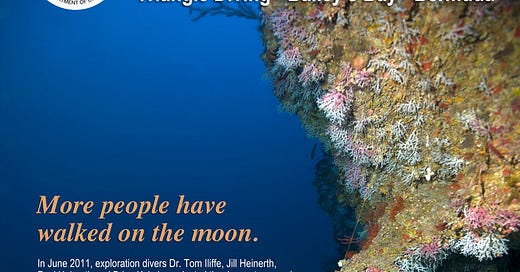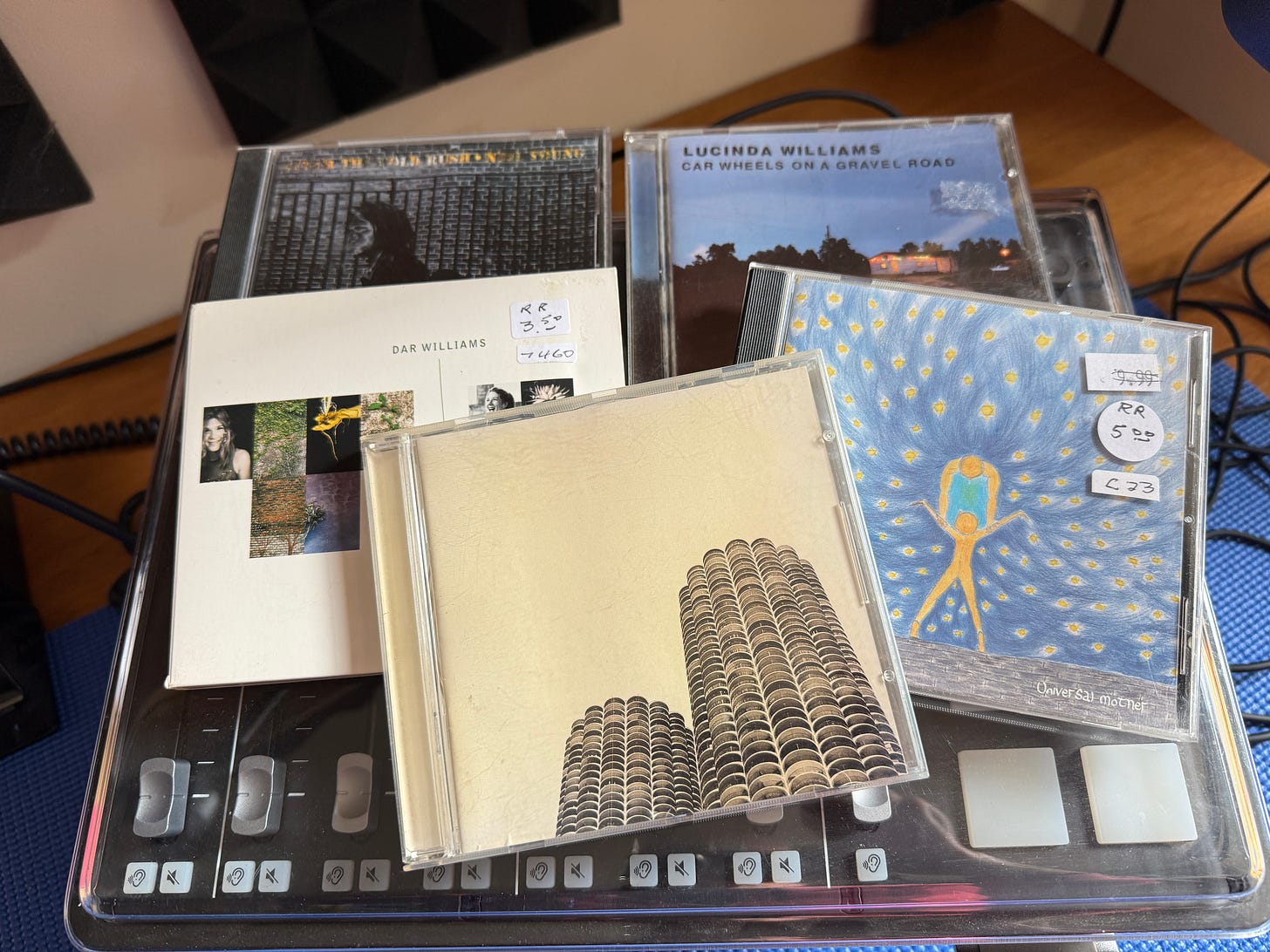Bermuda Deep
We had worked toward this dive our whole lives, though none of us would’ve said it out loud. The mission was simple in its madness: drop over 200 feet into the open ocean, find the peak of a forgotten volcanic seamount, and then descend another 250 feet or more into the abyss to hunt for caves and traces of undocumented life. Bermuda Deep wasn’t easy to explore, but we aimed to change that
Poster for NOAA Bermuda Deep Project. Photo: Jill Heinerth
I glanced at a pasty Tom Iliffe, a zoologist whose face had seen more time in caves than anyone I could imagine. We scanned each other’s gear with the efficiency of those who know their lives depend on it. Backup regulators were within arm’s reach. Tanks were analyzed and checked, and our rebreathers were ready to go. We nodded to the support team on the vessel Pourquoi Pas—a question we’d answered long ago. Why not? And then we dumped the air from our wings and plunged into the black.
Three minutes was all it took to reach the time-beaten crown of Challenger Sea Mount—just three minutes to leave everything above behind. The world shrank. It was just us, the fading sunlight somewhere far overhead and the endless twilight below. A single lionfish hovered near a tuft of soft coral, its spines waving in the current like the last survivor of an ancient war. Our hook dangled at the end of its line, our connection to the boat above.
Tom quickly tied his safety reel to the hook, vanishing over the edge of a precipice that might as well have led to another world. Minutes passed before he found a ledge at 460 feet. Beyond that, there was nothing—just a sheer wall falling forever into the twilight, where no person had been before.
But there we were. Tom, who I’d always known to be slow and methodical, moved with a frenzy that didn’t fit him. We had minutes on the ledge, maybe less. He tore through the task list like a man possessed—hammer swinging, arms grabbing at rock and coral like some mad archaeologist. It was as if he was trying to save every last relic before the earth swallowed them again. I captured what I could with my camera, observing as he crammed samples into mesh bags, making sure there were two of everything.
I shifted my lens to the wall itself—fragile, alien corals flared purple and red like fire licking the stone, interrupted only by sponges that seemed to glow with a light all their own. Schools of jacks darted through the water, curious or confused, while graceful permit fish reflected the little light that reached us, their bodies mirrored phantoms in the gloom.
In those few minutes, we touched something no one had touched before. Over 50 species of plants and animals made their way into Tom’s bags—some new, some lost to time. Geologists would later analyze the rock and the photographs, trying to piece together a timeline of history. There were ancient wave-cut ledges and overhangs created when the sea was lower and the land higher. Maybe the life in those remote places had come from the deep, migrating upwards like ghosts from a forgotten past, or perhaps they had always been there, waiting to be found.
There is a lot we don’t know about Bermuda’s twilight zone. We know more about the void above us, about stars that died before our time, than the living world hidden beneath these waters. Maybe some things are meant to remain out of reach. But for those lucky enough to descend into the depths, into this remote atoll in the Atlantic, Bermuda Deep is a reminder that the unknown is never as far as we think. Sometimes, it’s just 450 feet down, waiting.
What are we listening to?
Almost every evening, as our day winds down, Jill and I sit in our living room (lounge) and listen to music. I’m usually online perusing the news of the day and Jill is answering emails or planning her next trip to our local farmer’s market. It is a nice way to transition from a work day to a restful evening at home.
Popular music of all genres has always played an important role in my life. From jazz and world music to folk, rock, and classical, I listen to and appreciate the artists who created it. Here’s a sample of what is loaded into our CD player at the moment:
Neil Young- After The Gold Rush / Includes 2 of my favorite of Young’s songs - “Only Love Can Break Your Heart” and “Southern Man.”
Lucinda Williams - Car Wheels On A Gravel Road / Perhaps the greatest Americana music album of all time. My favorite woman singer/songwriter. Absolute genius from start to finish.
Dar Williams - The Green World / If you have a “Swiftie” in your life please introduce them to Dar Williams. How in the world is she not a household name is a mystery to me. “Playing to the Firmament” and “Spring Street” are gems that coulda-shoulda been huge mainstream hits.
Sinead O’Conner - Universal Mother / Quite simply, a gift from Ireland to the world.
Wilco - Yankee Hotel Foxtrot / If you like Steely Dan, the Eagles, Wings, Derek & The Dominos and Traffic, you will find something you will like in Wilco. “I Am Trying To Break Your Heart”, “Jesus, Etc”, and “Heavy Metal Drummer” may have paved the way for what is today called “Adult Alternative” music. Look into the saga of how this album was recorded and originally released on the band’s website for a glimpse into the dysfunctional state of the corporate music business.
You may have noticed that we prefer physical media over streaming music. I predict that CDs are about to make a big come back. If you can find a functioning CD player now is the time to snatch it up and make your way to your local flea market to buy used discs. As the streaming algorithms and AI based music proliferates, taking charge of your own music preferences in the form of vinyl, discs, and yes - even cassette tapes is a smart choice.
What are you listening to? What do you recommend? Let us know in the comments.






Details? OC/CCR? Gas mixes, deco profile? That must have been the dive of a lifetime!